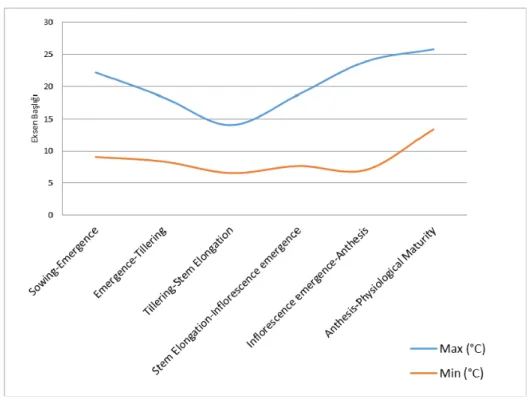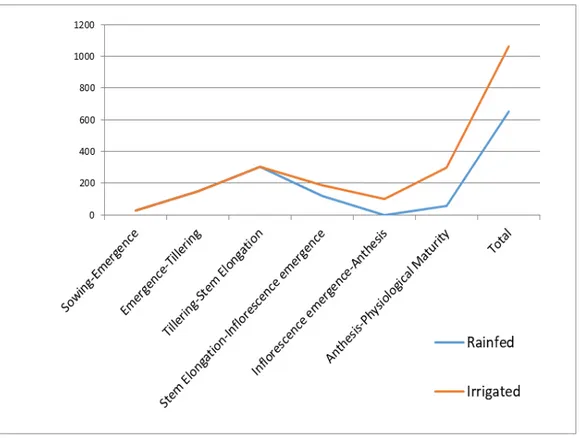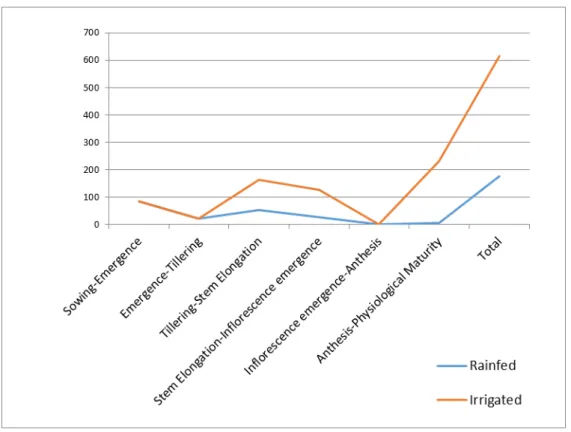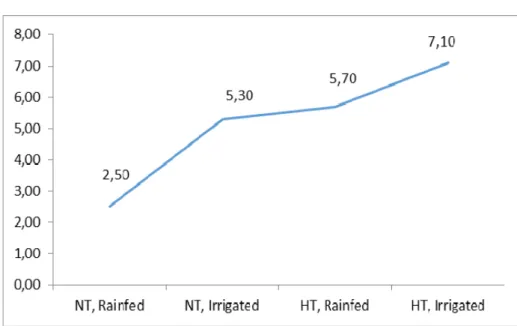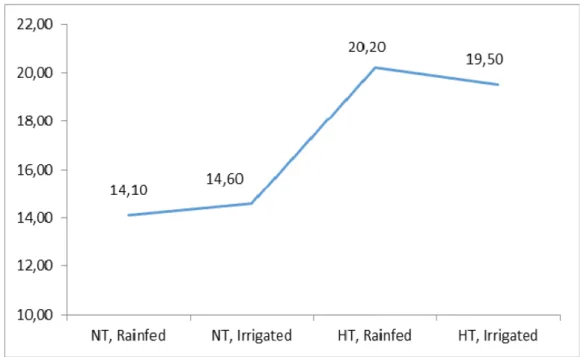Received: 03 July 2017 Accepted: 22 December 2017 Nitrogen Concentrations of Different Plant Parts of Wheat at Anthesis and
Maturity Under Normal and High Temperature Conditions
Uğur SEVİLMİŞ
Eastern Mediterranean Agricultural Research Institute, 01370 Adana, Türkiye, ugur.sevilmis@tarim.gov.tr
Abstract
Understanding nitrogen dynamics of wheat under different temperature conditions may provide valuable informations to maintain the sustainability of wheat production, improve food security and reduce production costs. A field trial was established to observe and evaluate nitrogen concentrations of different wheat plant parts at anthesis and maturity under normal and high temperature conditions. Two different temperature regimes were provided by planting seeds at two different calender times (normal wheat sowing time and a quite late time to receive warmer conditions). Also two different irrigation regimes were applied to distinguish the impact of drought from temperature.
On the plant parts basis, nitrogen concentration was maximum at flag leaf and minimum at lower stem both at anthesis and maturity. On the basis of temperature regimes, nitrogen concentrations were higher at high temperature regime compared to normal temperature regime for each plant parts both for anthesis and maturity except upper stem at maturity. Irrigation was increased nitrogen concentrations of each plant parts both at anthesis and and maturity under normal temperature regime. But oppositely, irrigation has a reducing effect on nitrogen concentrations of each plant parts both at anthesis and and maturity under high temperature regime except again at upper stem anthesis maturity. Nitrogen concentration of husks-awn-axis at maturity was
dergipark.gov.tr/adyusci
increased both by high temperature and irrigation applications. Nitrogen concentration of spikes at anthesis was higher under high temperature. Nitrogen concentrations of grains at maturity was increased by high temperature and was maximum at high temperature rainfed condition.
Our investigations showed that nitrogen concentrations of flag leaf, lower leaves and lower stem followed same pattern between applications and there exists a correlation between grain nitrogen concentration.
Keywords: Wheat, High Temperature, Heat Stress, Nitrogen.
Normal ve Yüksek Sıcaklık Koşulları Altında Buğday Bitkisinin Farklı Aksamlarının Çiçeklenme ve Olgunluktaki Azot Konsantrasyonları Özet
Farklı sıcaklık koşullarında buğdayın azot dinamiğini anlamak, gıda güvenliğini artırarak ve üretim maliyetlerini düşürerek buğday üretiminin sürdürülebilirliğini korumak için değerli bilgiler sağlayabilir. Normal ve yüksek sıcaklık koşulları altında çiçeklenme ve olgunlukta buğday bitkisinin farklı parçalarının azot konsantrasyonlarını gözlemlemek ve değerlendirmek için bir tarla denemesi yürütülmüştür. İki farklı zamanda tohum ekerek (normal buğday ekme zamanı ve sıcak koşulların sağlanabileceği oldukça geç bir zaman) iki farklı sıcaklık rejimi sağlanmıştır. Ayrıca, kuraklığın etkisini sıcaklıktan ayırmak için iki farklı sulama rejimi uygulanmıştır.
Bitki aksamları bazında azot konsantrasyonu hem çiçeklenme hem de olgunlukta bayrak yaprakta en yüksek, alt sapta en düşük bulunmuştur. Sıcaklık rejimleri baz alındığında, olgunlukta üst sap hariç, hem çiçeklenme hem de olgunlukta, her bitki parçasında normal sıcaklık rejimine kıyasla yüksek sıcaklık rejiminde azot konsantrasyonları daha yüksek bulunmuştur. Sulama, normal sıcaklık rejimi altında, tüm bitki aksamlarının azot konsantrasyonlarını hem çiçeklenme hem de olgunlukta artırmıştır. Sulama, yüksek sıcaklık rejimi altında ise üst sap hariç tüm bitki aksamlarının hem çiçeklenme hem de olgunlukta azot konsantrasyonları üzerinde
Çiçeklenme döneminde başaktaki azot konsantrasyonu yüksek sıcaklık rejimi altında daha yüksek olmuştur. Olgunlaşma dönemindeki tanelerin azot konsantrasyonları, yüksek sıcaklık ile artmış ve yüksek sıcaklıkta yağışa dayalı koşullarda maksimum olmuştur. Araştırma, bayrak yaprağı, alt yaprak ve alt sap azot konsantrasyonlarının uygulama esnasında aynı paterni izlediğini ve dane azot konsantrasyonu ile arasında bir korelasyon bulunduğunu göstermiştir.
Anahtar Kelimeler: Buğday, Yüksek Sıcaklık, Isı Stresi, Azot.
1. Introduction
Possible effects of global warming on crops is not very clear and high temperature probably reduces yields [1]. Global warming is threatening food security and poverty [2]. High temperature stress is a problem in 40% of temperate environments [3]. High temperature restricts plant growth and productivity and is an important environmental factor for many crops [4]. Information on effects of high temperature on various parameters of wheat are inadequate [5].
The productivity of most of the ecosystems is controlled by nitrogen availability [6]. The performance of wheat is mainly determined by the nitrogen supplied by the soil and fertilizer where plant demand for nitrogen reflects the current state of the plant [7]. According to [8] the majority of nitrogen fertilizer under Mediterranean conditions were taken in the period between tillering-anthesis and fertilization and irrigation practices increased the efficiency of water use where irrigation should be required at critical periods in the these conditions. Environmental conditions during grain-filling of wheat may affect the accumulation of storage protein and starch and effects grain yield and quality [9]. Grain protein content and grain weight are the most important parameters determining grain quality in wheat [10] and grain protein content is inversely related to grain size [11]. Heat stress allows more nitrogen per starch [12] and grain protein content where quality increases under heat stress [13]. Heat stress during grain-filling affects the grain protein content [14] and the greatest increase in wheat grain protein content occurs when heat stress occured at early grain filling period [15]. Nitrogen fertilization increases wheat protein contents [16]. Delayed application of nitrogen in
the season is more effective than earlier applications [17]. Near anthesis application of nitrogen is more efficient than earlier application for increasing grain protein content [18]. [19] reported that protein concentration of grain might be improved by translocation of a higher percentage of nitrogen from the vegetative organs to the grain. Plant nitrogen concentration is successfully used as an indicator of nitrogen status [20].
2. Materials and Methods
Research was conducted on research and application fields of University of Cukurova in Turkey in 2003-2004 wheat growing season. Research area is located at 36°29' North latitude and 35°18' East longitude at 20 m altitude. Test area is flat with high soil clay content [21]. Adana-99 bread wheat cultivar was used in the study. Trial fields were left for fallow in 2002-2003 season. Sowing was done after cultivation of trial area and plots received 500 seeds per m2. Normal sowing (normal temperature NT) was done on 17 November 2003, late sowings (high temperature regime-HT) was done on 04 March 2004. Interrow distance was 15 cm, plot lenght was 6 m to form 8 lines. 80 kg ha-1 N, 80 kg ha-1 P2O5, 80 kg ha-1 K2O and 5 kg ha-1 Zn was given as
composite fertilizer (15-15-15+ 1 Zn) at sowing. In the beginning of tillering (on 27.12.2003 at normal planting, and on 29.03.2004 at late planting) 80 kg ha-1 N as ammonium nitrate (26%) fertilizer was applied. At stem elongation (for normal planting on 29.01.2004, for late planting on 22.04.2004) 40 kg ha-1 N as ammonium nitrate (26%) fertilizer was applied. Irrigation was done with drip irrigation. Lateral interspace was 30 cm and dripper interspace was 50 cm. Soil water was determined by gravimetric measurements weekly. Irrigation was done when first 60 cm of the soil profile available water level falls to 60%. Irrigation was carried out to fill the amount of water in the soil profile to field capacity under control of water meter. Daily average temperatures under NT (Normal Temperature) regime for 2003-2004 growing season is given in Figure 1.
Figure 1. Actual Average Daily Temperatures Under NT Regime
Daily average temperatures under HT (High Temperature) regime for 2003-2004 growing season are given in Figure 2.
Two temperature regimes were provided by planting at two different times (normal wheat sowing time and quite late time to receive warmer conditions). In order to distinguish the impact of drought from temperature, two different irrigation regimes were applied. Amount of water that research area received as precipitation and irrigation in year 2003-2004 under NT regime is given in Figure 3.
Figure 3. Amount of Water That Research Area Received Under NT Regime (mm)
Amount of water that research area received as precipitation and irrigation in year 2003-2004 under HT regime is given in Figure 4.
Figure 4. Amount of Water That Research Area Received Under HT Regime (mm)
Investigations were conducted according to the method described mainly by [22]. Used Zadoks Growth Scale to follow plant phenological developments [23]. To determine the amount of N, certain lengths in the middle part of the plots were cut from the soil surface and divided into different plant sections. These different plant parts dried at 70 °C for 48 hours and N content was determined by Khejdal method. These procedures has applied separately to the samples taken from the plots at anthesis and maturity. For this purpose, during anthesis, spikes, flag leaf, the lower leaves, upper stem, lower stem, sterile stem and during ripening grain, husks-awn-axis, flag leaf, lower leaves, upper stem, lower stem, sterile stems has used. Heat regime was main and irrigation was sub-factor and trial has established by the randomised block design with four replications. MSTAT-C program package has used for the statistical analysis of datas. The resulting averages was analysed by LSD.
3. Results
High temperature application drastically reduced the duration of phenological periods except anthesis-maturity period. Phenological durations are given in Figure 5.
Figure 5. Phenological Durations Under Different Temperature Regimes (day)
Total vegetation period was 178 days for the NT regime and 97 days for the HT regime. The most affected stages from HT were "sowing-tillering" and "stem elongation-anthesis" periods.
Comparison of N concentrations (mg nitrogen per kg dry matter) of flag leaf, lower leaves, upper stem and lower stem at anthesis and maturity are given in Figure 6.
N concentration of flag leaf, lower leaves and lower stem were higher under HT conditions compared to NT condition both for anthesis and maturity. Irrigation had concentration reducing effect under HT but inreasing effect under NT. This pattern was same for upper stem maturity but different at anthesis. Upper stem N concentration at anthesis was increased both by high temperature and irrigation.
N concentration of husks-awn-axis at maturity was increased both by HT and irrigation; and was maximum at HT irrigated condition (Figure 7).
Figure 7. N Concentration of Husks-Awn-Axis at Maturity (mg N kg DM-1)
N concentration of spikes at anthesis was higher at HT and irrigation made no significant effect on it on both of the temperature regimes (Figure 8).
Figure 8. N Concentration of Spikes at Anthesis (mg N kg DM-1)
N concentrations of grains at maturity were increased by HT and were maximum at HT rainfed condition (Figure 9).
4. Discussion
When we compare plant parts, N concentration was maximum at flag leaf which is followed by lower leaves, upper stem and lower stem both at anthesis and maturity for both temperature regimes.
When we compared applications, N concentration was higher at HT regime and lower at NT regime for each plant part and for both stages except upper stem maturity. Irrigation increased N concentrations of each plant parts both at anthesis and maturity under NT regime. But oppositely, irrigation reduced N concentrations of each plant parts both at anthesis and maturity under HT regime except upper stem anthesis at maturity. N concentration of husks-awn-axis at maturity was increased both by HT and irrigation. N concentration of spikes at anthesis was higher at HT. N concentrations of grains at maturity was increased by HT and was maximum at HT rainfed condition.
Investigations showed that N concentrations of lower leaves, flag leaf and lower stem followed same pattern between applications in correlation with grain nitrogen concentration.
Acknowledgements
This study is supported by University of Cukurova (Project No: 2F.2005.YL.11). The author thanks to Prof. Dr. Mujde Koc and Assoc. Prof. Dr. Celaleddin Barutcular for their contributions.
References
[1] Semenov, M. A., Impacts of climate change on wheat in England and Wales, Journal of the Royal Society Interface, 2008.
[2] Tubiello, F. N., Rosenzweig, C., Goldberg, R. A., Jagtap, S. and Jones, J. W., US national assessment technical report effects of climate change on US crop production part I: wheat, potato, corn, and citrus. Vol. 2011, University of Florida: NASA-GISS and Columbia University, 2000.
[3] Reynolds, M. P., Oritiz-Monasterio, J. I. and McNab, A., Application of physiology in wheat breeding, Mexico, D. F: CIMMYT. 240 p., 2001.
[4] Noohi, K., Fatahi, E. and Kamali, G. H. A., Heat stress effects analysis on wheat crop in southern provinces, Geophysical Res Abstracts. 11, 4441, 2009.
[5] Singh, N. B., Singh, Y. P. and Singh, V. P. N., Variation in physiological traits in promising wheat varieties under late sown condition, Indian Journal of Plant Physiology, 10(2), 171-175, 2005.
[6] Vitousek, P. M., Hattenschwiler, S., Olander, L. and Allison, S., Nitrogen and nature, Ambio, 31, 97-101, 2002.
[7] Jamieson, P. D. and Semenov, M. A., Modelling nitrogen uptake and redistribution in wheat, Field Crops Research, 68(1), 21-29, 2000.
[8] Garabet, S., Wood, M. and Ryan, J., Nitrogen and water effects on wheat yield in a Mediterranean - type climate: I. Growth, water-use and nitrogen accumulation, Field Crops Research, 57(3), 309-318, 1998.
[9] Moffatt, J. M., Sears, R. G. and Paulsen, G. M., Wheat high temperature tolerance during reproductive growth. I. Evaluation by chlorophyll fluorescence, Journal of Crop Science, 30, 881-885, 1990.
[10] Coles, G. D., Hartunian-Sowa, S. M., Jamieson, P. D., Hay, A. J., Atwell, W. A. and Fulcher, R. G., Environmentally-induced variation in starch and non-starch polysaccharide content in wheat, Journal of Cereal Science, 26(1), 47-54, 1997.
[11] Erekul, O. and Kohn, W., Effect of weather and soil conditions on yield components and bread making quality of winter wheat (Triticum aestivum L.) and winter triticale (Triticosecale Wittm.) varieties in North-East Germany, Journal of Agronomy and Crop Science, 192(6), 452-464, 2006.
[12] Stone, P. J. and Nicolas, M. E., The effect of duration of heat stress during grain filling on two wheat varieties differing in heat tolerance: grain growth and fractional protein accumulation, Functional Plant Biology, 25(1), 13-20, 1998.
[13] Borghi, B., Corbellini, M., Minoia, C., Palumbo, M., Di Fonzo, N. and Perenzin, M., Effects of Mediterranean climate on bread-making quality, Eur. J. Agron, 6, 145-154, 1997.
[14] Gooding, M. J., Ellis, R. H., Shewry, P. R. and Schofield, J. D., Effects of restricted water availability and increased temperature on the grain filling, drying and quality of winter wheat, J. Cereal Sci., 37, 295-309, 2003.
[15] Castro, M., Peterson C. J., Rizza, M. D., Dellavalle, P. D., Vazquez, D. and Ross, A., Influence of heat stress on wheat grain characteristics and protein molecular weight distribution, In: Wheat Production in Stressed Environment, 365-371. Springer Netherlands, 2007.
[16] Knowles, T. C., Dooerge, T. A. and Ottman, M. J., Improved nitrogen management in irrigated durum wheat using stem nitrate analysis: II. Interception of nitrate-N contents, Agron. J., 83, 353-6, 1991.
[17] Kelley, K. W., Rate and time of N application for wheat following different crops, J. Prod. Agric., 8, 339-45, 1995.
[18] Wuest, S. B. and Cassman, K. G., Fertilizer-N use efficiency of irrigated wheat: I. Uptake and efficiency of pre-plant versus late season application, Agron. J., 84, 682-8, 1992.
[19] Robert, N., Hennequet, C. and Bérard, P., Dry matter and nitrogen accumulation in wheat kernel: Genetic variation in rate and duration of grain filling, J. Genet. Breed., 55, 297-305, 2001.
[20] Fageria, N. K., The Use of Nutrients in Crop Plants, Boca Raton, Florida, USA: CRC Press, Taylor & Francis Group, LLC, 2009.
[21] Ozbek H., Dinc, U., Kapur, S., Çukurova Üniversitesi Yerleşim Sahası Topraklarının Detaylı Temel Toprak Etüt ve Haritası, Ç. Ü. Ziraat Fakültesi Yayınları: 73, Bilimsel Araştırma ve İncelemeler, 8, 149, 1974.
[22] Bell, M. A. and Fischer, R. A., Guide to plant and crop sampling, measurements and observations for agronomic and physiological research in small grain cereals, Wheat Special Report, No:32 Mexico, D. F. CIMMYT pp. 66, 1994.
[23] Zadoks, J. C., Chang, T. T. and Konzak, C. F., A decimal code for the growth stage of cereals, Weed Research, 14, 415-421, 1974.
